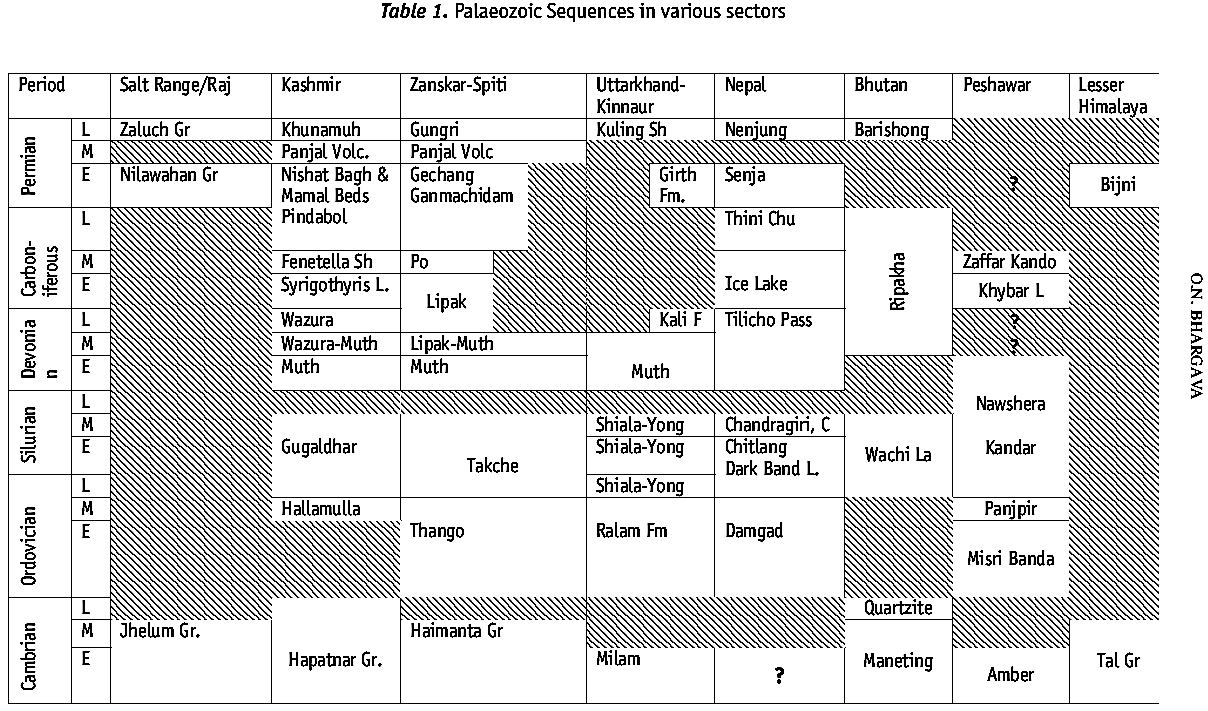Takche Fm
Type Locality and Naming
Reference section: Lies on left bank of Takche Nala, Spiti River (Srikantia et al. 1976, Srikantia, 1981) [Original Publication: Srikantia, S. V., Ganesan, T. M., Sinha, P. K. and Tirkey, B. 1976. Geology of Part of Zanskar Mountains, Ladakh Himalaya with special reference to late Caledonian “Kurgiakh Orogeny”. “Geology, Mineral Resources and Natural Resources of Power Development of Himalayas with particular Reference to Kashmir”. Geological Survey of India, Abstracts, 1–3. Srikantia, S.V., 1981. The lithostratigraphy, sedimentation and structure of Proterozoic–Phanerozoic formations of Spiti basin in the Higher Himalaya of Himachal Pradesh, India. In: Sinha, A.K. (Ed.), Contemporary Geoscientific Researches in India (a commemorative volume in honor of S.P. Nautiyal). Bishen Singh Mahendra Pal Singh, Dehra Dun, pp. 31–48.]
Synonyms: Pin Formation (Suttner, 2003; Myrow et al., 2018)
[Figure: Zanskar-Spiti-Kumaun region location (provided by Om Bhargava)]
Lithology and Thickness
Dolomite. Comprised of dolomite, dolomitic limestone, siltstone, shale and quartzite. Nearly >150-200 m thick
[Figure 1: Field photograph of the Takche Formation at Gechang locality in Parahio Valley, Spiti region]
Relationships and Distribution
Lower contact
Gradational contact with underlying the Thango Fm.
Upper contact
Disconformable contact with overlying Muth Fm.
GeoJSON
Fossils
Lower Member: Dasyclad green algae (Vermiporella sp.); tabulate corals; trilobites; crinoids; tentaculites (Tentaculites sp.); brachiopods; graptolites; Takche Member: cyanobacteria (Girvanella sp., Girvanella cf. problematicus, Girvanella cf. tasmaniaensis, Renalcis sp., Rothpletzella sp.); dasyclad green algae (Apidium indicum, Coelosphaeridium shianense, Dasyporella sp., ?Plexa sp. and Vermiporella sp.); red algae (?Graticula sp.); stromatoporoids; tabulate corals (Favosites sp., Halysites sp., Heliolites sp.); rugose corals; gastropods (Euomphalus sp.); cephalopods (Allumettoceras pinense, Cyrtogomphoceras centrifugum, Lambeoceras farkamuthense, Orthoceras cf. annulatum and Oxygonioceras latum); palaeoscolecides (Milaculum sp.); scolecodonts; trilobites; ostracodes (Glossomorphites himalayaensis, Krausella ? shianensis, Pilla pinensis, Pinpilla uformis Steusloffina cuneata and Vendona crassiplicata); crinoids; tentaculites (Tentaculites sp.); cornulitids (Cornulites sp.); brachiopods (orthids, strophomenids, Leptaena sp.); bryozoans (Calloporella harrisi, Ceramopora sp., Cladodictya markhensis, Corynotrypa sp., Cyphotrypa yak, Dekayia gregaria, Dekayia sp., Discotrypa aff. elegans, Enallopora ulrichi, Eridotrypa suecica, Insignia sp., Kukersella Borealis, Lichenalia concentrica, Oanduellina himalayaica, Orbignyella aff. lamellosa, Pesnastylus? vesiculosum, Phaenopora ordinarius, Phaenopora sp. Pinocladia triangulata, Prasopora yushanensis, Ptilodictya exiliformis, Ralfina? originalis, Revalotrypa? sp., Stellatodictya plana, Trematopora minima, Ulrichostylus bhargavai);
Conodonts: Amorphognathus ordovicicus, Belodina confluens, Icriodella superba, Panderodus sp.); Upper Member: tabulate corals; crinoids; cornulitids (Cornulites sp.); brachiopods (lingulids); bryozoans (Helopora fragilis); conodonts (Icriodella cf. discreta, Ozarkodina sp.)
Silicified representatives of the ostracode orders Binodicopa, Palaeocopa and Podocopa have been recovered (Schallreuter et al., 2007).
Age
Depositional setting
Strong influence of storm processes on a regressive shallow shelf. Bhargava and Bassi (1998) regarded it to represent several shoaling cycles beginning from middle-lower shore face and ending in upper shore face near undathem (microfacies belt 7 of Wilson, 1975) and subtidal-intertidal interface, with periodic storm episodes. Buildups were formed on the platform part mainly in low energy regime (Bhargava and Bassi, 1998)
Additional Information


